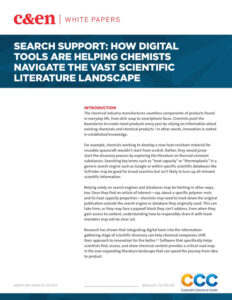Promises that new digital tools will make our lives easier inundate our inboxes and media consumption. Adopting any new tool comes with a learning curve that consumes time and cognitive resources. How can science marketers show their audience that the benefits of a new software tool, computational technique, or piece of automated lab equipment will be worth the cost of learning how to use it? Storytelling.
At C&EN BrandLab, storytelling is one of the ways we create content that inspires people to imagine possibilities. A common framework that we use for storytelling is:
- Science need
- The challenge
- Solution
- Transformation
Here’s how two high-performing white papers and an ebook follow this framework.
Search Support: How Digital Tools are Helping Chemists Navigate the Vast Scientific Literature Landscape
A White Paper Sponsored by the Copyright Clearance Center
- Science need: The vast scientific literature is an essential tool to identify ideas with room for novel research and development.
- The challenge: The chemical information space, already millions of articles in size, grows by more than 450,000 new articles each year. Publishers have different approaches to access and copyright licenses.
- Solution: Software, such as RightFind from the Copyright Clearance Center, can make it easier for scientists to search the literature, access articles, and share relevant information with their colleagues.
- Transformation: Adopting digital tools can free scientists to focus on driving product development.
Scaling Structure-Based Drug Design with Machine Learning
A White Paper Sponsored by Cresset
- Science need: Computer-aided drug design (CADD) techniques can speed up the lengthy and costly process of drug discovery.
- The challenge: Speed, scale, and calculation accuracy are hard to achieve at the same time.
- Solution: To scale highly accurate calculations, researchers are working to join machine learning to resource-intensive CADD techniques available with some of Cresset’s tools.
- Transformation: Computational chemistry combined with machine learning could provide rich information in the early stages of drug discovery, ideally directing experimental resources towards the most promising drug candidates.
A Grand Synthesis: Automation is Changing How Scientists Synthesize Chemicals
An eBook Sponsored by MilliporeSigma
- Science need: Synthetic chemistry—the art of making complex chemical compounds from simpler ones—is fundamental to the chemical industry.
- The challenge: Traditional methods rely on specialized equipment and laborious manual work.
- Solution: Automated synthesis platforms, such as Synple from MilliporeSigma, can perform a variety of reactions commonly used in the pharmaceutical industry through a system that’s as straightforward as making coffee.
- Transformation: The Synple automated synthesis platform speeds reactions and improves consistency, freeing synthetic chemists to focus on innovation rather than tedious manual labor.
Looking to show your audience how an innovative tool can benefit their workflow? Use storytelling frameworks to link your solution to a transformation of a common problem.





















